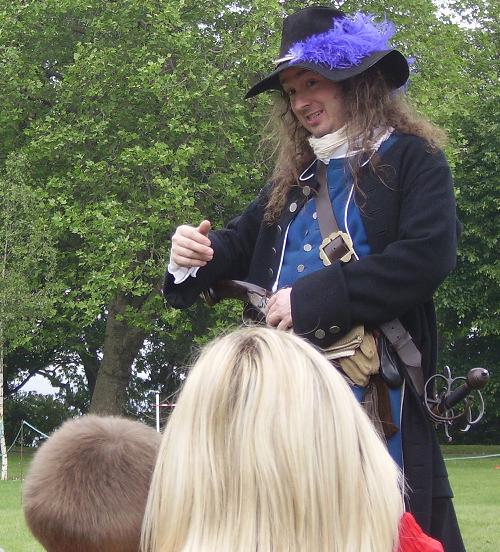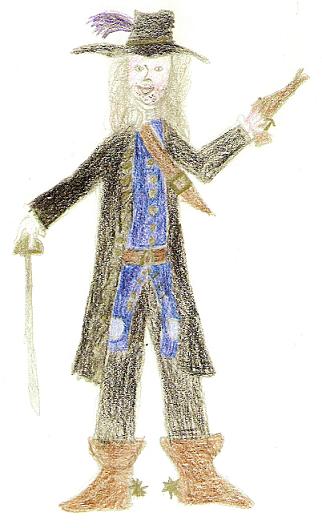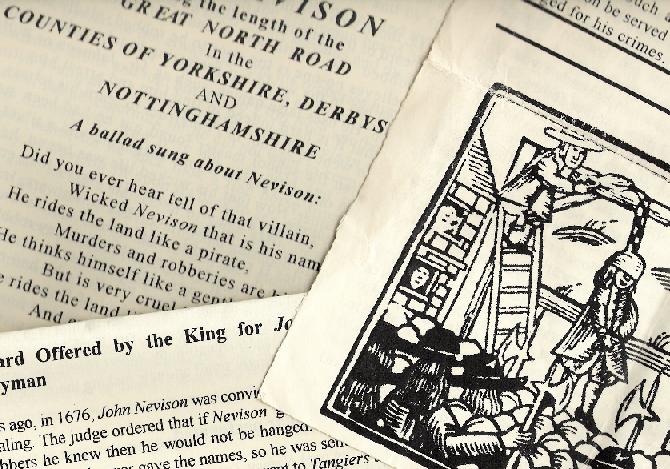For years 5 and 6 and older (and occasionally years 3 or 4)
 Having a highwayman arrive unexpectedly to hide in your school makes for a very exciting day. The children are drawn into his predicament, and fascinated by tales of his exploits. I have lost count of the number of times teachers have told me that this day gives children a real reason to write, even those who usually avoid such work.
Having a highwayman arrive unexpectedly to hide in your school makes for a very exciting day. The children are drawn into his predicament, and fascinated by tales of his exploits. I have lost count of the number of times teachers have told me that this day gives children a real reason to write, even those who usually avoid such work.
This character not only fits in very well with a study of Alfred Noyes’ poem, The Highwayman, but also suits a experiential learning approach to all sorts of topics (from journalistic writing to adventure stories, from historical fiction to persuasive writing). It also has a cross-curricular link with the KS2 history study of ‘an aspect or theme in British history … beyond 1066’, specifically: ‘crime and punishment from the Anglo-Saxons to the present’.
The session is a great way to start work on Noyes’ poem, as it very effectively introduces the historical context of the setting and types of characters, leaving the children brimming with background knowledge. It is also great for continuing or ending the unit, stimulating class discussions and additional research.
 The session addresses all sorts of other elements, like exploring language for comic and dramatic effects; understanding different points of view; comparing themes in poetry, prose and other media; and experimenting with narrative forms and styles. It is also great for narrative units concerning traditional stories, fables, myths, legends. Nevison claims to be like ‘Robin Goodfellow’ (AKA Hood), and a descendant of all the ‘Goodfellows’ through time, from Hereward the Wake to Captain Hind. He himself became a Yorkshire Legend – nicknamed ‘Swift Nicks’ for being the legendary highwayman who rode from London to York in one day. On the day the children feel involved with the creation of these legends, putting down on paper Nevison’s tales and correcting the stories that (according to Nevison) lie about him to make him seem like a villain!
The session addresses all sorts of other elements, like exploring language for comic and dramatic effects; understanding different points of view; comparing themes in poetry, prose and other media; and experimenting with narrative forms and styles. It is also great for narrative units concerning traditional stories, fables, myths, legends. Nevison claims to be like ‘Robin Goodfellow’ (AKA Hood), and a descendant of all the ‘Goodfellows’ through time, from Hereward the Wake to Captain Hind. He himself became a Yorkshire Legend – nicknamed ‘Swift Nicks’ for being the legendary highwayman who rode from London to York in one day. On the day the children feel involved with the creation of these legends, putting down on paper Nevison’s tales and correcting the stories that (according to Nevison) lie about him to make him seem like a villain!
Find out More...
A day with a Highwayman!
There are several different formats and versions of this visit. The character works very well as a whole day session with one class, but just as well with two, three or even four classes. I will discuss specifically what format would work best in advance of the visit &/or on the morning itself. Like all my character days, the component timings are flexible, to suit the numbers and school timetable, and to allow individual classes to work at a pace that suits their learning.
Session Format for Key Stage 2
Introduction
|
Writing tasksThese are main focus of the day. I use up to four differentiated texts. Two need correcting (re-writing), another must be responded to with a letter, and another I want both an image and its labels changed. Volunteer pupils (or teacher chosen) read the texts aloud. After each reading I claim the stories were wrong, and then recount my own versions, explaining how things were quite different. I am not the villain described in the pamphlets, but more like Robin Hood, and so a proper hero! I then ask the children if they would put these things right. This involves … (a) Re-writing parts of a news-sheet – a higher ability task. There are several different stories for individual children to choose from. I want people to read tales I can be proud of, not the lies printed about me. There are two different forms of this news-sheet, in different font sizes. The more difficult of the two, with some archaic English spelling, is accessible to the highest ability Year 6 children, but the more frequently used one is much more accessible. (b) Composing a letter to the London Gazette to complain about a recent article in which I am described as a coward and a murderer! I want the children to correct the editor, and describe what they think I am really like, having met me and heard my own account of his adventures. (c) Re-writing a slanderous ballad to make me sound heroic and generous. (d) Creating a false description of me to be passed around the local watchmen, in the form of a wanted poster. Hopefully this would buy me time to escape! This is the lowest ability task, and involves the labeling of a picture. I give full instructions to set up these tasks. When I am working with more than one class, I set up tasks (b), (c) and (d) so that they go away with work to do while I begin to visit each of the classes in turn. When I am with individual classes, I address the stories of activity (a) as setting up that task in the assembly would take too long. The children then do this written work either as differentiated groups or by choosing which task they want to do, in which case the tasks are effectively differentiated through outcome. Task (d), which all the children usually want to do, can become an extension task for the more able children should they finish their first task(s). When I work with more than one class, the written work is done while I am with the other class(es), so that the children are either with me or have work to do for me. When I am with just one class all day, I have more time with the children, so that as they work I can visit groups in turn to spend 10 minutes or so with each – playing a card or dice game, or Nine Men’s Morris, or looking at maps or coins, etc. While I sit with one group, the others get on with their tasks. This written session usually takes about one hour. At the end of the day with more than one class children read out some examples of their work, or present their posters. With one class we can do this as they have completed the tasks. Either way, I am able to comment on and approve of their work. |
The Big Story
It is just the right time for such a story, as the children have become immersed Nevison’s world, his adventures and boasts, and they listen so well that you can hear a pin drop! This YouTube video is extracted from a older version of the story I usually tell. https://www.youtube.com/watch?v=TKsg8hs22uM |
Find out More...
A day with a Highwayman!
The following optional activities are usually for days where I can work with one class all day (although there are ways to incorporate some of them into multi-class days) …
Option: Children’s Own StoriesI wonder whether the children, being educated scholars, could teach me some tricks. Perhaps how to escapes jail or a constable? Or how to trick a rich man? Or how to rescue a friend, etc. I want the children to come up with ideas I myself might be able to use in future! They then work in groups to plan the little stories in note form (or whatever planning style they are used to). While they work, I move around offering ideas and suggestions. Finally, the groups, in turn, can either tell or act out their tales for me and the rest of the class. |
Option: Sketching (art-work)Having written corrected stories and ballads, I might want a good likeness drawn to go with them. I can thus pose for the children while they all sketch a portrait, using whatever medium you think is best. Usually they simply sketch and shade in pencil, sometimes ‘working up’ the picture at a later time. |
Option: Question and Answer
The pupils and teacher can do the questioning here, asking whatever they want – about my life, childhood, life in the 17th century, whatever. This can go in many directions – from food to school to houses to London. If they’ve been studying highwaymen, I can ask them if know about the law: officers of the law, courts, prisons, punishments, etc., which could lead to some gory accounts of the ‘triple gallows’ at Tyburn or the traitors’ heads over London bridge! |
For Key Stage 3 children the sessions involve question and answer about late seventeenth century crime and punishment, woven amongst Nevison’s humorously exaggerated tales. This way I can work in succession with several smaller groups. Various elements from the Key Stage 2 activities can be incorporated also.
“Your final story was amazing, I couldn’t believe it! Literally. No man (plus horse) could go from Kent to York (over two hundred miles) in less than a day. Not even Nutmeg! I would like to say thank you again for a phenomenal day. I really enjoyed it! Hope you come again … “
“A fabulous visit once again. Paul has been coming to Airedale for six years now. We plan our journalistic writing topic to fit in with John Nevison! All the children enjoy the visits and produce excellent follow up work. It is a highlight of Year 6. Thank you Paul.”
“We have enjoyed an inspirational day. We will be able to go on and do some wonderful work.”
“Had an excellent day today. The children really enjoyed all the activities and their faces when you walked in to the assembly were excellent! Thanks for all the ideas, we’ll be using loads of them in Literacy.”
“The children were engaged as soon as he walked through the door and remained so well after he left. A great day which really helped the children’s historical understanding.”
… the amazing day you spent at our school … Thought I must tell you that the children(and adults too) thoroughly enjoyed your visit. The children said that it had been the best day in year 5 this year! You were very entertaining and the children learnt SO much about highwaymen in the past. They are keen to finish what they started in class today – it’s great when they enjoy writing so much! We will definitely book you again in the future and recommend you to other classes and schools.
Just want to say a big thank you for a brilliant day, yet again. A lot of the children said how much they enjoyed it and that it’s the best topic they had done this year. A number of them asked me if I’d had chance to see your horse, Nutmeg!
I just wanted to send a huge thank you for a truly brilliant day, on behalf of us all. The children were so engaged and you had them all enthralled with your entertaining stories! They all left hoping you would come back tomorrow, and are so excited by the topic so thanks again. It was a pleasure to have you in class. Thanks again, I will definitely be recommending you to all my teacher friends!

 After I burst into the classroom or hall, I discuss who and what I am, why I need to hide, and what it is about my possessions and clothes that might indicate I am a highway robber. I explain any strange words I use and answer questions. Last, I ask the children if they have ever read stories about me, which leads me on to the setting up of some writing tasks.
After I burst into the classroom or hall, I discuss who and what I am, why I need to hide, and what it is about my possessions and clothes that might indicate I am a highway robber. I explain any strange words I use and answer questions. Last, I ask the children if they have ever read stories about me, which leads me on to the setting up of some writing tasks.
 At the very end of the day, I tell the famous story of my ride from London to York, which is a great way to round the visit off. If I have worked more than one class that day, we can have a plenary assembly to hear some examples of their work, and then have the story.
At the very end of the day, I tell the famous story of my ride from London to York, which is a great way to round the visit off. If I have worked more than one class that day, we can have a plenary assembly to hear some examples of their work, and then have the story.


